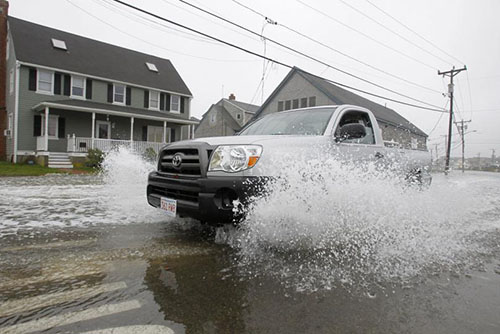There’s a lot of stories recently about what climate change will ultimately do to coastal cities — in The New Yorker recently, there was kind of a humor piece about how sharks might be swimming up to the second floor of Miami apartments by 2100 or so. I doubt that’s specifically true, but this whole arc is a bit closer than we think. Now there are new studies about what cities, to this point, have been the most affected by climate change in terms of “nuisance flooding,” which is defined as happening during high tides and shutting down traffic, closing businesses, leading to increased destruction of streets, etc — in a word, a “nuisance.” This new study looked at over 60 years of climate change and coastal flooding data (you can read the entire thing here), and it found that the cities with the greatest increase in terms of “nuisance flooding” as measured in the period from 1957 to 1963 (Period A) and again in 2007 to 2013 (Period B):
1. Annapolis, MD — 925 percent increase
2. Baltimore, MD — 922 percent increase
3. Atlantic City, NJ — 682 percent increase
4. Philadelphia, PA — 650 percent increase
5. Sandy Hook, NJ — 626 percent increase
Everything in the top 10 was along the eastern seaboard except for Port Isabel, Texas (547 percent increase) and San Francisco, CA (364 percent increase). Two major U.S. cities for employment and innovation — DC and San Francisco — were in the top 10, along with Baltimore and Philly, which are major I-95 corridor cities. Remember: that’s America’s wealth corridor, and it’s also an area getting hit potentially the hardest by nuisance increases related to climate change that slow down business cycles. That doesn’t bode well, generally speaking.
In short, nuisance floods — which admittedly are minor at this point, in the grand scheme of things — are essentially at all-time highs along the east coast, and only expected to rise.
The interesting flip side to this is that while we’ve all been discussing 20-foot high water surges — something that’s probably 200 years away, if even that — maybe the idea of persistent nuisance flooding in major Eastern cities will start to get more done in terms of climate change awareness. There will always be deniers, yes, but it’s kind of like the idea that if gas goes to $10/gallon in California, you’ll start to see Tesla ramp up out there in terms of infrastructure, production, etc. As they say, desperate times, desperate measures, right?
